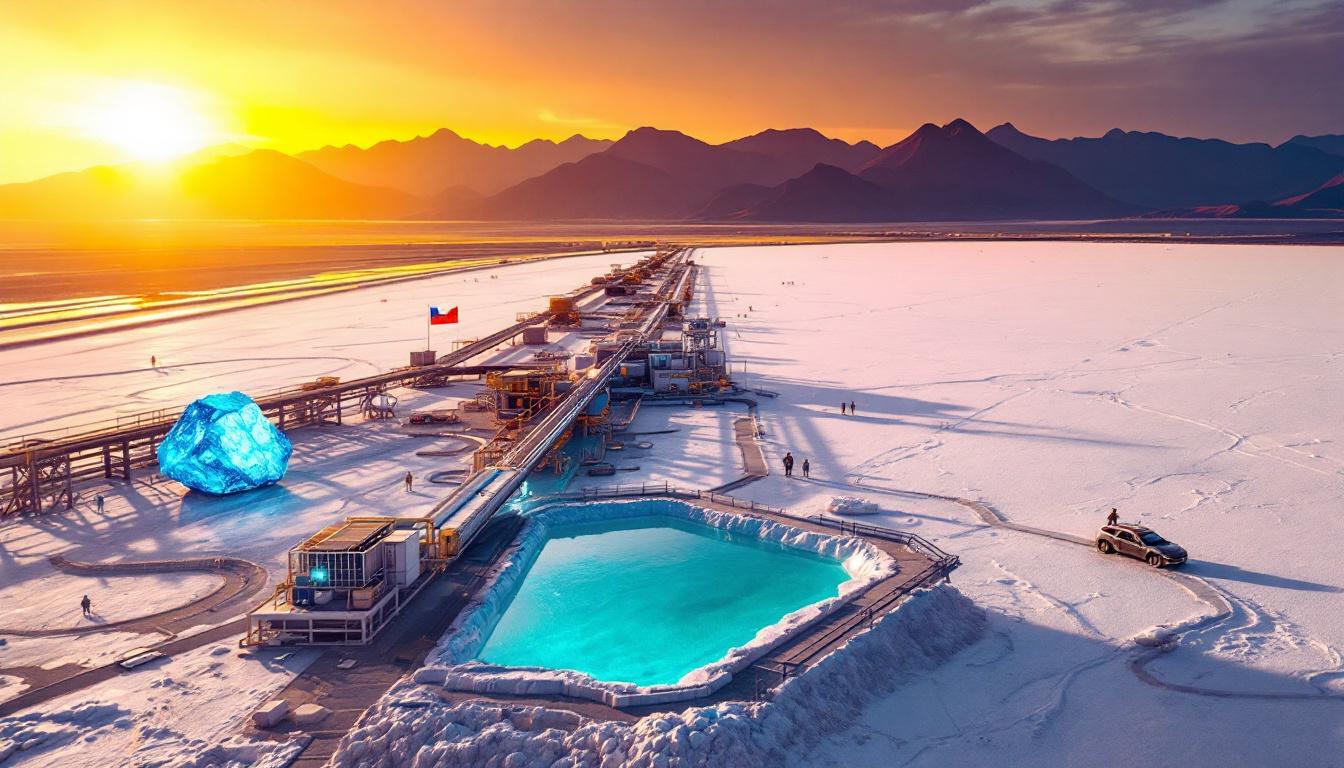Why Is Albemarle's US Lithium Refinery Project On Hold?
Albemarle Corporation, a leading global producer of lithium, has indefinitely suspended plans for its $1.3 billion lithium processing facility in South Carolina, citing unfavorable market conditions that have decimated lithium prices. According to Benchmark Mineral Intelligence, lithium prices have plummeted by 74% over the past two years, creating an economic environment where new refining projects in the United States simply cannot compete with established overseas operations.
"The math doesn't work today," Albemarle CEO Kent Masters explained bluntly when discussing the project's suspension. This frank assessment highlights the fundamental challenge facing domestic lithium processing: despite strategic importance, commercial viability remains the primary driver of investment decisions.
The price collapse stems largely from a global oversupply crisis, with Chinese producers significantly expanding output and flooding the market with refined lithium products. This supply glut has created a brutal pricing environment where even well-capitalized Western companies struggle to justify major capital expenditures.
The Economic Challenge of Domestic Lithium Processing
The economics of lithium refining illustrate the classic tension between national strategic priorities and commercial realities. Building and operating lithium refineries in the United States involves substantially higher costs than in competing regions, particularly China, which dominates the global processing landscape with approximately 60% of worldwide lithium refining capacity.
These cost differentials emerge from several factors: higher labor expenses, stricter environmental regulations, longer permitting timelines, and more expensive energy costs. When lithium prices were at their peak in 2022, these disadvantages could be absorbed while still maintaining profitable operations. However, with prices now at multi-year lows, the financial case for domestic refining has evaporated.
Industry analysts estimate that the breakeven price point for new Western lithium refineries is approximately $20,000 per ton—well above current market prices hovering around $15,000 per ton. Without significant cost reductions or government support, this gap makes projects like Albemarle's South Carolina facility commercially nonviable.
Strategic Implications for US Supply Chain
The indefinite pause on Albemarle's refinery project represents a significant setback for U.S. efforts to develop an independent lithium supply chain. Currently, the United States operates just one commercial lithium mine—a Albemarle-controlled operation in Nevada—and has minimal domestic refining capacity to convert raw lithium into battery-grade materials.
This limited domestic capability creates a strategic vulnerability at a time when lithium has become essential to the energy transition. Without sufficient refining capacity, U.S. battery manufacturers and electric vehicle producers remain dependent on overseas suppliers, particularly from China.
The implications extend beyond commercial considerations into national security territory. Lithium has been designated a critical mineral by the U.S. government, and its availability directly impacts the nation's ability to achieve clean energy objectives and maintain technological competitiveness in strategic industries.
"Private companies are not going to be able to do it on their own," Masters emphasized when discussing the challenges of developing Western supply chains that can compete with international producers. This statement underscores the growing recognition that market forces alone may be insufficient to establish domestic lithium processing capacity.
How Does This Impact US Energy Independence Goals?
The suspension of Albemarle's lithium refinery project exposes a fundamental disconnect between U.S. policy objectives and market realities. The Biden administration has made strengthening domestic supply chains for critical minerals a cornerstone of its economic and climate strategies, but commercial viability continues to dictate corporate investment decisions.
Government Policy vs. Market Reality
Several federal initiatives aim to reduce dependency on foreign lithium supplies, including provisions in the Inflation Reduction Act that provide tax credits for domestically sourced battery materials. However, these incentives have proven insufficient to offset the economic advantages enjoyed by overseas processors.
The Department of Energy and other federal agencies have allocated billions in funding to support domestic battery supply chains, but much of this has focused on manufacturing capacity rather than raw material processing. This has created a situation where even if battery production increases domestically, the critical materials inside those batteries will still largely come from overseas refineries.
For the South Carolina facility to proceed, Albemarle executives have indicated that more direct government support would be necessary—potentially including loan guarantees, grants, or tax incentives specifically targeted at processing facilities. Without such intervention, the project remains in limbo, highlighting the gap between policy ambitions and implementation.
Competitive Landscape Analysis
While Albemarle pauses its U.S. refining plans, international competitors are making strategic moves during the market downturn. Rio Tinto, the global mining giant, has been actively acquiring lithium assets, positioning itself for an eventual market recovery while asset valuations remain depressed.
Chinese refiners continue to expand capacity despite current oversupply conditions, further strengthening their dominant market position. These companies benefit from lower operating costs, state support, and vertical integration with battery manufacturers, allowing them to weather price volatility more effectively than their Western counterparts.
Albemarle, meanwhile, lacks what Masters described as a "war chest" for significant acquisition activity in the current environment. Instead, the company is focusing on operational efficiency and selective investments in next-generation technologies that might provide competitive advantages when navigating lithium volatility improves.
This divergence in strategy between Western and Chinese producers threatens to widen the existing gap in refining capacity, potentially making it even more difficult for the U.S. to establish domestic lithium processing when prices eventually recover.
What Alternative Strategies Is Albemarle Pursuing?
Despite the South Carolina project pause, Albemarle isn't standing still. The company is pursuing several alternative strategies to maintain competitiveness during the market downturn while positioning for future recovery.
Global Operations Focus
Albemarle's current strategy emphasizes maximizing returns from existing operations, particularly its high-margin assets in Chile's Salar de Atacama—one of the world's richest lithium brine deposits. The company has evaluated but declined bidding on additional Chilean salars, preferring to optimize current operations rather than expand during the price trough.
The company is also making targeted investments in direct lithium extraction (DLE) technologies in both Chile and the United States. These technologies promise to extract lithium more efficiently than traditional evaporation methods, potentially reducing costs and environmental impacts while increasing recovery rates.
In Chile, Albemarle has implemented pilot projects testing DLE systems that could eventually replace or supplement conventional evaporation ponds. These innovations could prove crucial in maintaining cost competitiveness in a challenging market environment.
Financial Performance Adaptation
Despite the challenging market conditions, Albemarle has reported better-than-expected quarterly results, demonstrating its ability to adapt to lower prices through operational efficiency improvements and cost control measures.
The company has also implemented an auction-based sales model for some of its lithium contracts, designed to improve price transparency and potentially capture upside during periods of market tightness. This approach represents a shift from traditional long-term fixed-price agreements toward more dynamic pricing mechanisms that better reflect lithium market trends 2024.
Masters has established an internal pricing threshold for resuming the South Carolina project, though the specific figure remains undisclosed. This metric creates a clear decision point for reactivating development plans when market conditions improve sufficiently to justify the investment.
The focus on operational efficiency and financial discipline reflects Albemarle's strategy to ensure competitiveness "at the bottom of the cycle"—positioning the company to survive the current downturn while maintaining optionality for future expansion when prices recover.
What Are The Technical Challenges of Lithium Refining?
Lithium refining involves complex technical processes that present significant engineering, environmental, and economic challenges, contributing to the difficulties in establishing domestic processing capacity.
Processing Complexities
Converting raw lithium into battery-grade materials requires specialized facilities that can achieve the 99.5% purity levels demanded by battery manufacturers. This conversion process differs substantially depending on the source material:
-
Brine operations (like those in Chile) pump lithium-rich saltwater into evaporation ponds where solar concentration occurs over 12-18 months, followed by chemical processing to remove impurities.
-
Hard rock mining (common in Australia) requires crushing, roasting, leaching, and multiple purification steps to produce lithium hydroxide or carbonate.
Both approaches require significant capital investment, specialized equipment, and technical expertise. The South Carolina facility would have processed spodumene concentrate from hard rock mines, requiring chemical conversion processes that are energy-intensive and technically demanding.
Environmental considerations add another layer of complexity. Lithium processing generates wastewater, requires chemical reagents, and consumes significant energy. Meeting U.S. environmental standards increases project costs compared to jurisdictions with less stringent regulations.
Innovation Opportunities
The technical challenges of traditional lithium processing have spurred research into alternative approaches, with direct lithium extraction (DLE) emerging as one of the most promising innovations.
DLE technologies use selective adsorption, ion exchange, or membrane processes to extract lithium directly from brines without requiring extensive evaporation. These approaches offer several potential advantages:
- Reduced processing time (hours versus months)
- Smaller physical footprint
- Lower water consumption
- Higher recovery rates (potentially 70-90% versus 40-50% for evaporation)
- Greater geographic flexibility
Albemarle has invested in DLE research and pilot projects, recognizing its potential to transform the economics of lithium production. If successfully scaled, these technologies could potentially reduce the cost disadvantage facing U.S. operations and make projects like the South Carolina facility more competitive.
However, DLE technologies remain unproven at commercial scale, with questions about resin durability, energy requirements, and effectiveness across different brine chemistries. The balance between adopting innovative lithium production technologies versus relying on established processes presents a strategic dilemma for companies like Albemarle.
How Does The Global Lithium Market Influence Domestic Projects?
The economics of Albemarle's South Carolina facility cannot be understood in isolation—global market dynamics fundamentally shape the viability of all lithium projects, regardless of location.
Supply-Demand Dynamics
Current market conditions reflect a significant oversupply situation, with production capacity outpacing demand growth. Global lithium output increased approximately 35% in 2024, while demand growth from electric vehicle manufacturers and energy storage systems grew at a slower pace of around 25%.
This imbalance has created inventory buildup throughout the supply chain, with estimates suggesting global lithium stockpiles reached approximately 200,000 metric tons by the end of 2024. Industry analysts project this oversupply situation could persist through 2025 and potentially into 2026, depending on electric vehicle adoption rates and production discipline.
Price transparency has historically been limited in lithium markets, with most transactions occurring through private contracts rather than open exchanges. This opacity has contributed to boom-bust cycles, as producers and consumers lack clear signals about true market conditions.
Albemarle's adoption of auction-based sales strategies represents an attempt to address this transparency issue, potentially creating more accurate price discovery mechanisms. However, regional price variations continue to create market complexity, with Chinese domestic prices often diverging from international benchmarks.
International Competition Factors
Chinese dominance in refining capacity creates an uneven competitive landscape. Chinese processors benefit from:
- Vertical integration with battery manufacturing
- Lower labor costs
- Faster permitting timelines
- Government subsidies and financing support
- Established infrastructure and supply chains
South American production remains concentrated in the "lithium triangle" of Chile, Argentina, and Bolivia, with expansion plans ongoing despite current low prices. Chile's SQM and Albemarle continue to develop their operations in the Atacama, while Argentina is advancing several new projects in partnership with international investors.
Australian mining operations, primarily focused on hard rock spodumene, have faced particular pressure during the downturn, with several mines suspending operations due to low prices. However, the country remains the world's largest lithium producer by volume and continues to promote Australia's lithium ambitions.
New entrants from African nations like Zimbabwe and Democratic Republic of Congo are beginning to enter the market, potentially adding to supply pressures in coming years, though infrastructure limitations may slow their impact on global markets.
What Would It Take To Revive The South Carolina Project?
Restarting Albemarle's South Carolina project would require a combination of market improvements, policy support, and potentially technological advances to overcome current economic barriers.
Economic Threshold Requirements
For the project to proceed, lithium prices would need to recover substantially from current levels. While Albemarle has not publicly disclosed its specific price threshold, industry analysts suggest that sustained prices above $20,000 per ton would likely be necessary to justify the $1.3 billion investment.
This price recovery would require either:
- Supply rationalization – Production cuts from high-cost producers, particularly in Australia and China
- Accelerated demand growth – Faster-than-expected electric vehicle adoption or energy storage deployment
- Both factors operating simultaneously – The most likely scenario for rapid price recovery
Government incentives could lower this price threshold by offsetting capital costs or operating expenses. Potential mechanisms include:
- Direct grants covering a portion of construction costs
- Loan guarantees reducing financing expenses
- Tax credits based on production volume
- Accelerated depreciation allowances
- Preferential procurement policies for domestically refined materials
Strategic partnerships could also distribute investment risks, potentially involving battery manufacturers, automakers, or other downstream consumers with vested interests in supply security.
Policy Considerations
Several policy approaches could enhance the viability of domestic lithium processing:
-
Targeted federal support: Programs specifically designed for midstream mineral processing, similar to the DOE Loan Programs Office's support for manufacturing but focused on refining operations.
-
Tax incentives: Specialized tax credits for processors of strategic minerals, potentially modeled after Canada's 30% Critical Minerals Exploration Tax Credit.
-
Regulatory streamlining: Expedited permitting pathways for projects deemed critical to national security, potentially through expansion of the FAST-41 program.
-
National security designation: Formal recognition of lithium processing as essential to defense and security interests, potentially unlocking additional funding mechanisms.
These policy tools would need to be deployed within the constraints of international trade agreements and WTO rules to avoid triggering disputes or retaliatory measures from trading partners.
How Does This Compare To Other Lithium Projects?
While Albemarle has paused its South Carolina facility, other lithium projects continue to advance, suggesting that specific project economics rather than industry-wide conditions determine viability.
Comparative Project Analysis
American Battery Technology Company (ABTC) recently secured $900 million in conditional loan interest from the Department of Energy for its planned lithium mine and processing facility in Nevada. This project benefits from an integrated approach combining extraction and processing, as well as proprietary technologies that may reduce costs.
FG's recent $1.3 billion lithium deal with a major Korean battery manufacturer demonstrates selective investor confidence in well-positioned projects. This vertical partnership model, linking upstream resources directly with guaranteed offtake agreements, helps mitigate market risks.
Rio Tinto's Rincon lithium project has also continued to advance despite market headwinds, demonstrating that high-quality assets can attract investment even in challenging conditions.
Lyten has begun U.S. production of battery-grade lithium metal using innovative lithium-sulfur chemistry, demonstrating that specialized, higher-value lithium products can achieve viability even in challenging market conditions.
These contrasting outcomes highlight how project-specific factors—resource quality, technology approach, offtake agreements, and capital structure—can substantially impact viability during market downturns.
Investment Trends
Current investment patterns show a clear preference for:
- Highest-quality resources – Projects with exceptional grade, scale, or extraction costs
- Technological differentiation – Approaches that offer cost or performance advantages
- Vertical integration – Partnerships spanning multiple supply chain segments
- Strategic positioning – Assets in politically stable jurisdictions with supportive policies
Technology-focused investments have shown particular resilience, with capital continuing to flow into DLE startups and advanced battery materials companies despite broader market challenges. This suggests investors are making long-term bets on innovation-driven cost reductions rather than near-term market recovery.
FAQ: Understanding The US Lithium Industry
What is the current state of US lithium production?
The United States currently has only one operational lithium mine located in Nevada's Clayton Valley, controlled by Albemarle. This operation produces approximately 5,000 metric tons of lithium carbonate equivalent annually—less than 2% of global production.
Domestic refining capacity remains extremely limited, with most raw lithium materials shipped overseas for processing before returning as battery-grade compounds. This creates a critical vulnerability in the supply chain, as more than 80% of lithium used in U.S. manufacturing comes from imported refined products.
Why are lithium prices declining despite growing EV demand?
Lithium prices have fallen 74% over the past two years primarily due to overproduction, especially from Chinese refiners, outpacing growth in demand. This supply-demand imbalance created approximately 200,000 metric tons of excess inventory throughout the supply chain by late 2024.
Additionally, EV sales growth has moderated in some markets, particularly Europe, where incentive reductions and economic concerns have temporarily slowed adoption rates. Chinese domestic EV sales continue to grow rapidly, but increased local production has more than satisfied this demand.
Finally, speculative positions that drove prices to unsustainable heights in 2022 have unwound, contributing to price volatility
Seeking To Capitalise On The Next Major Mineral Discovery?
Stay ahead of the market with Discovery Alert's proprietary Discovery IQ model, delivering instant notifications about significant ASX mineral discoveries and transforming complex data into actionable trading opportunities. Visit the Discovery Alert discoveries page to understand how major mineral discoveries can lead to exceptional returns and begin your 30-day free trial today.




